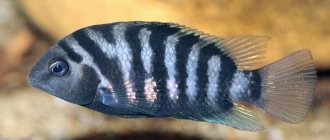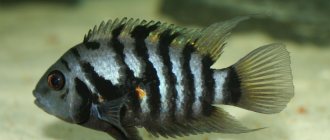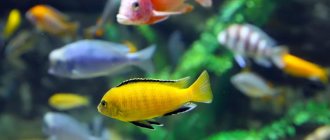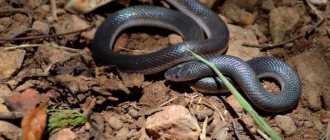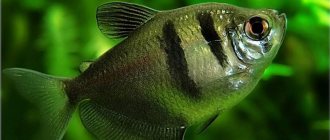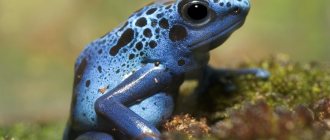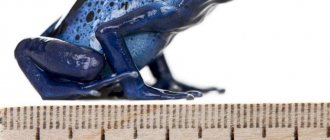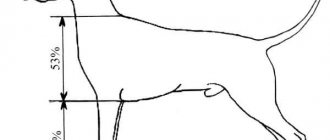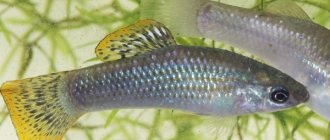Diamond cichlid (lat. Herichthys cyanoguttatus, formerly Cichlasoma cyanoguttatum) is a fairly large, beautiful, but at the same time quite aggressive cichlid. In nature, it lives in the rivers of Texas (for example, the Rio Grande) and northern Mexico. This fish is often confused with another species - Geophagus brasiliensis, but these are two different fish and Geophagus is better known as pearl cichlasoma.
The Diamond Cichlid is one of the aggressive and large cichlids, somewhat similar to the Managuan Cichlid. It reaches 30 cm in length, which is larger than the average size of African and many American cichlids. But in an aquarium it is usually smaller, about 20 cm.
Despite its violent temperament, territoriality and size, cichlid has many fans among aquarists. They are captivated by the fact that this is one of the most richly colored cichlids, and they proudly display it in their large species aquariums.
They have typical cichlid behavior, that is, they dig the soil, carry stones and gravel, and pull out plants. This is a very smart fish that recognizes the owner and looks through the front window when he approaches.
One of the advantages of diamond cichlases is that they are very easy to breed.
However, they are extremely territorial, aggressive, and cannot stand it when someone encroaches on their territory. They attack plants, decor, aquarium equipment, even the owner's hand, so the best thing is to keep them separately, without plants and delicate equipment.
Description
Distinctive features of disc cichlazoma:
- The body is in the shape of an irregular oval, hence the prefix - disk cichlazoma.
- The frontal line is concave.
- The back is rounded.
- The head is large.
- The upper and lower jaws are the same length.
- Adults in captivity reach 20–25 cm.
Diamond cichlazomas are capable of producing interspecific offspring. One of the results of such crossing was the brilliant balloon cichlizoma.
Appearance
The colors of diamond fish are one of the most attractive among aquarium fauna:
- The base color is dark brown.
- On top there is a “diamond” layer of shimmering spots in blue and green shades.
- On the sides there are poorly defined lines of dark tones in the direction from the back to the abdomen.
- A dotted line of round, dark spots stretches from the base of the caudal fin to the head.
Behavior
All cichlids are very active by temperament. Diamond disc cichlisomas have character and behavior characteristics that future owners need to take into account:
- Aggressiveness on a scale of 10 is around 6–7.
- They move a lot and plow up the bottom soil, regardless of its composition.
- They release many waste products.
- They feed so actively that food particles can be scattered throughout the tank.
- Requires a lot of space to move.
Some experienced owners claim that the fish recognize them when approaching the aquarium. If the cichlids do not like some element of the decoration, it is better to remove it from the container. It is in the nature of these fish to break everything that they do not like.
Lifespan
The average lifespan of cichlids is 7–10 years. Compliance with all the rules for the maintenance and care of these representatives of cichlases allows you to extend their life in captivity to a respectable 15–17 years.
Notes
Pearl Cichlids are sometimes passed off as Texas Cichlids - a misleading common name often given to Herichthys Carpintis - even though they are a completely different species of fish from the one we know as the Texas Cichlid (Herichthys cyanoguttatus). This is what is commonly called the Green Texas Cichlid.
Texas cichlid (Herichthys cyanoguttatus) appearance.
The two species are very similar in appearance, which often leads to confusion, but their spots differ in size and shape. Herichthys cyanoguttatus has very small, relatively uniform dotted spots, whereas Herpthys carpintis has larger, patchy spots. Moreover, male Texas cichlids do not have a pronounced growth on the frontal part.
Content
Fish are not particularly demanding in terms of care and living conditions; they are omnivores. They prefer animal food to a greater extent. You should not forget about plant feeding, otherwise the flora of the aquarium will suffer.
The second most important condition after volume is the correct division of the aquarium into zones. The presence of at least 3 types of landscape is important:
- Vegetable area.
- Free area for loosening the soil. If this point is not provided for in advance, the fish themselves will choose a place for excavation.
- An area with various types of cover. When choosing the decorations in which the fish will hide, consider the size of the adults.
If you plan to keep 2 pairs of cichlases, multiply all the indicated zones by 2. Otherwise, the fish themselves will begin to divide the aquarium in half.
Aquarium
We select the size of the aquarium for cichlases based on the following factors:
- Adults are large - 20–25 cm.
- They move a lot and actively.
- They always show territorial aggression.
The best tank parameters for keeping a pair of individuals:
- Volume 250–300 l.
- Length 1–1.3 m.
- A lid is required.
Water parameters
In their natural habitat, cichlids spend most of their time in the middle layer of the water area. Temperature changes from season to season are more than 20 degrees. Such living conditions have developed excellent adaptive qualities in cichlases. Diamond cichlazomas are not particularly picky about their contents.
Reviews
Petrova Inga, 41 years old, Samara. I have 2 turquoise fish in my aquarium. Their appearance is certainly fascinating, but the individuals are cocky, and it is difficult to find neighbors for them.
Pavlova Tatyana, 26 years old, Saratov. Not long ago I met the diamond cichlid. If it weren’t for the beautiful color, I would give them away, they are very aggressive and muddy the water, I have to constantly clean the aquarium.
Diamond disc cichlid is a beautiful aquarium fish native to Texas, for which it is sometimes called the Texas cichlid. Keeping a pet is not difficult, but you need to create the right conditions. The fish chooses its neighbors carefully.
Feeding
Diamond short-bodied cichlasoma is an omnivorous species. The diet in the natural environment is:
- Plants.
- Insect larvae.
- Small to medium sized clams.
- Shrimps.
- Fish up to 4–5 cm.
- Fry.
In captivity, the diet should be based on 30% plant food and 70% animal food. Tolerant of all types of feeding:
- Dry.
- Fresh.
- Frozen.
- Alive.
A plant-based diet includes:
- Duckweed.
- Salad leaves.
- Cabbage.
- Cereals.
Before feeding the plants, treat them with steam or boiling water.
Protein feed:
- Dry combined mixtures.
- Tubifex.
- Gammarus.
- Artemia.
- Bloodworm.
- Minced fish fillet.
- Squid and shrimp, preferably minced.
Don't forget, diamond cichlises are prone to obesity.
Share what you feed your cichlids.
Breeding
This species is capable of crossing with other varieties (severum, Eliot, leopard, etc.) . Thanks to these breeding features, diamond cichlazoma disc, red, blue, green, eight-banded, and balloon appeared.
Red Diamond Cichlazoma is a hybrid.
Cichlids can reproduce when males grow up to 10 cm, and females 7 cm. This happens approximately in the eleventh month of life. You can stimulate spawning by changing the water and increasing its temperature. During it, males develop a pointed vas deferens, and females are characterized by an ovipositor resembling a truncated pyramid.
Pointed vas deferens of cichlids
It is recommended to organize a separate container for spawning (from 80 l), although it is allowed to leave fish in a common aquarium. Before throwing eggs, females clean the surface - the bottom of the aquarium, a smooth stone, is suitable for this. Diamond cichlazoma lays a lot of eggs, sometimes the number of eggs is measured in the thousands (on average 1500).
Both parents protect future offspring. They dig a special hole where the female will then transfer the hatched larvae. The duration of the incubation period depends on the water temperature - the warmer it is, the faster the eggs ripen. The fry begin to swim around the fifth day.
Diamond cichlid fry with their parent.
Males take care of the offspring. Sometimes they are so protective of the fry that they even beat the females. They may even need to be isolated.
Feeding the fry does not pose any particular problems due to their size. First, you can use Artemia nauplii, then the food should be larger according to the growth of the fish.
Diamond cichlid is an interesting object for aquarium keeping. It attracts with its bright appearance, fairly large size, unpretentiousness to food and other conditions. When getting such a fish, it is important to remember that not all species can get along with it.
Compatibility
Diamond cichlases cannot be classified as peace-loving fish. Behavior is aggressive at all stages of growth.
Cichlids of this species are hostile:
- To representatives of their own species.
- To individuals of both sexes of adjacent species.
- To most fish of other families.
- Fish smaller than the cichlid itself are considered food items.
- They eat shellfish and shrimp up to 3–5 cm in size.
At the age of 7–10 years, aggression only increases, especially towards young members of their own species. If cichlazomas are a pair, they get along calmly in the same aquarium. Two couples living together can lead to territorial clashes.
Despite their fighting nature, some types of aquarium fish are perfectly compatible with diamond cichlids:
- Cichlazoma zebra (black striped).
- Large kalasoma (black pacu).
- Ocellated astronotus.
- Biocelatum (Cichlazoma bee).
- Turquoise cichlid.
- Barbels (barbs).
- Masked cichlazoma (meeka).
- Catfish pterygoplicht (brocade).
- Pelmatochromis.
- Giant gourami.
- Dragon fish (arowana).
- Pseudotropheus.
- Apteronotus (black prince).
All of the neighbors listed above, except parrots, are impressive in size. When choosing who to add to the diamond cichlid, think about the size of the aquarium you will need for this.
Share your experience of keeping a diamond cichlid with other fish.
Character
The Diamond Cichlid is one of the most aggressive cichlids. Fish defend their territory and also conquer it from others. The objects of attack are fish of other families, relatives and even crustaceans. Aggression increases during the breeding season. Not only the male, but also the female protects the nest. They show aggression towards all objects invading their territory.
The target of the attack can be the owner’s hand, objects behind the glass of the container that approach him. Cichlazoms can even jump out of the water to “get” the enemy. In order to reduce aggression, fish need space. When setting up an aquarium, you need to take into account the characteristics of the diamond cichlid.
Fish have quite developed intelligence. They recognize their owner. They can observe for a long time what is happening behind the walls of the aquarium. They are trainable - they can swim up to a signal and take food.
Reproduction
In aquariums, diamondfish breed freely. No special effort is required on the part of the owner. Individuals become sexually mature at the age of 1–1.3 years.
Sex differences
Sexual differences are given for sexually mature individuals of the same age:
| Differences | Female | Male |
| Size | 6–8 | 10–12 cm |
| Forehead | Concave line. | Pronounced bulge. |
| Dorsal and anal plumage | Rounded ends. | The endings are elongated and have a pointed configuration. |
| Anal hole | Resembles a truncated cone | Pointed cone |
Spawning
Fish of this species are able to spawn all year round. The required break is 60 days.
To start reproduction you need:
- Place the pair in a spawning container with a volume of 100 liters.
- Raise the temperature to 27–28 degrees.
- Double the water changes.
- Increase the volume of fluid replaced to 33–35%.
- There is no need to change the hardness and pH parameters.
With frequent reproduction, the number of eggs in one litter gradually decreases by 5 times. After fertilization, the male may behave hostilely, so he is placed in a common tank. The period of ripening of caviar is up to 7 days. She is cared for entirely by the female.
Suitable for feeding fry:
- Finely chopped tubifex.
- Artemia.
- Cyclops larvae.
- Chopped roundworms.
- Living dust.
How to distinguish a male and a female?
Sexual dimorphism in diamond cichlases is clearly visible. Males, as a rule, are larger than females, and they have a well-defined frontal tubercle. Before spawning, the male develops a vas deferens (like a pointed tube), and the female develops an ovipositor in the shape of a truncated pyramid.
Diseases
Like all cichlids, the diamond cichlid has no congenital prerequisites for diseases. Various pathologies arise only when the correct housing and feeding conditions are not observed.
To exclude diseases, you need to follow several rules:
- Water replacement should occur strictly every 6-7 days.
- It is recommended to buy food in specialized stores.
- You cannot feed cichlid larvae collected from nature.
- Pieces of vegetables must be treated with boiling water or steam before feeding.
- If a fish develops symptoms of any disease, it is urgently necessary to isolate it from other inhabitants. After this, treatment of the tank, equipment, soil and decorations with a solution of 3% hydrogen peroxide is required.
- If the soil is not purchased, it must first be treated with chlorhexidine or chloramine, and then calcined in the oven at a temperature of 180 degrees.
- Make sure that the requirements for the composition and temperature of the water remain within normal limits.
- Mandatory quarantine for new residents for 12–14 days.
By following these rules, you will keep your fish alive and healthy.
Diseases often found in cichlids:
Nutrition
Cichlases have a strong body, a lot of muscle mass and an impressive skeleton. To keep it in good shape they need a lot of live protein food.
Bloodworms, shrimp, tubifex, brine shrimp, and crickets are excellent for feeding diamond cichlid.
To replenish your fish's body with vitamins and beneficial microelements, feed them with granulated dry food for cichlids .
Feed your pets once a day. Make sure that portions are eaten quickly and without residue. If overfed, cichlazomas can become obese.
Photo gallery
Appearance
In the wild, this fish can be about thirty-five centimeters long; aquarium specimens, as a rule, grow only up to fifteen centimeters. They are characterized by a tall, elongated and strong body with flattened sides, a large head with a steep forehead, large eyes and thick lips, which allow them to easily dig in the ground, which they love to do. This fish has a very picturesque coloring, as you can see by looking at its photo.
Its body can have a different background color from light gray to dark brown. A wonderful scattering of emerald, silver and blue sparkle specks shines and shimmers on it. The area of the gill covers is decorated with similar patterns. When fish take care of their offspring, their chest and abdomen become black.
If a very dark spot appears in the middle of the body, then the cichlazoma is preparing for battle, and the unnatural pallor of the color indicates that it is in a stressful situation. The tail of the diamond cichlazoma is decorated with a large black spot with a shiny frame. The fin on the back is elongated.
Habitat
The cichlid is native to North America.
The natural habitat extends across large areas of the Rio Grande River basin, which is the natural border between the United States and Mexico. Inhabits areas of slow-flowing rivers, swamps, lakes and ponds with dense aquatic vegetation and numerous flooded snags. Brief information:
- Aquarium volume - from 300 liters.
- Temperature - 20–33°C
- pH value – 6.0–7.5
- Water hardness - soft or medium hard (5–13 dGH)
- Substrate type - sand or fine gravel
- Lighting - any
- Brackish water - no
- Water movement - weak to moderate
- The size of the fish is up to 30 cm.
- Food - any sinking food with herbal supplements
- Temperament - uncooperative with benthic species
- Keeping alone or in a mature male/female pair
